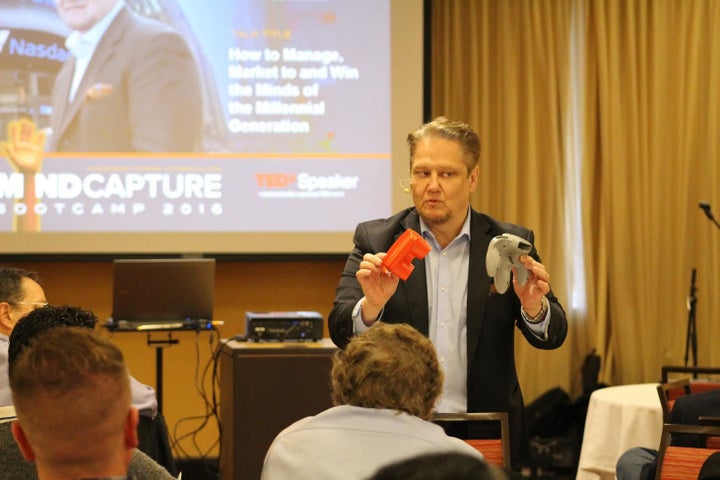
Brad Szollose, an entrepreneur, author, and speaker, shares his ideas on multigenerational management.
In an age where generational stereotypes about Boomers and Millennials are thrown about without clear understanding, the tension displayed by managers holding onto the "old ways" of leadership is visible. How does one lead in a time when hierarchies themselves are being destroyed?
This new age fueled by technology and its workforce requires an entirely updated set of best practices and a leader who is self aware enough to adapt and change, rather than fear the bumpy business terrain ahead of us. Brad Szollose, the authority on helping companies understand generational issues, coined the term "Liquid Leadership" to describe what it takes to succeed as a leader today: adaptability, transparency, and strength.
Szollose is a recognized thought leader, entrepreneur, business coach, and speaker who specializes in transitioning leaders from the Industrial Age to the Information Age, and his advice is not based on theory. Szollose has bootstrapped over 8 startups, one of which he took public in an IPO on NASDAQ, which was worth over $26 million. Based on his experience, here are his 7 best practices (multigenerational management ideas) that define what it means to be a liquid leader today.
1st Law: A Liquid Leader Places People First
Despite all the technology available to leaders today, they must understand that people are and will always be the most important asset of any company. "Baby Boomers tend to isolate themselves from younger people and treat them as expendable ‘kids’, while Millennials tend to undervalue the experience of Boomers and ignore them. Generation X, on the other hand, showed up on time, wore suits, and did everything the Boomers told them to do, and now are being overlooked for leadership positions for some reason," noted Szollose. “Liquid leadership is about being inclusive--creating opportunities for all generations to thrive within an organization.”
2nd Law: A Liquid Leader Cultivates an Environment Where It is Free and Safe to Tell the Truth
Micromanagement will be the death of a misguided leader in today's marketplace. Szollose said, "When responsibility is shifted to the individual--when people are given the freedom and power to manage their time and solve problems--the result is that no one wants to let down even a single member of their team."
It also means you must teach people how to manage themselves in this day and age. Szollose refers to Valve Software’s employee handbook… “A fearless adventure in knowing what to do when no one’s there telling you what to do.”
3rd Law: A Liquid Leader Nurtures a Creative Culture
Again, micromanagement cripples innovation and creates debilitating bottlenecks. This will sound frightening to some leaders, but "self-directed time management seems to work best" according to Szollose.
This requires relinquishing control. You can not dictate each minute of your employee's day and create a tidy to-do list that still somehow expects creativity. Instead, Szollose suggested "create an intense culture where raw, exciting, innovative ideas have a chance to incubate."
This is a management model from the design and advertising agency world. Hire the best and expect them to get the work done. Where there is anxiety, creativity is low. Where people are supporting profound work and anxiety is low, creativity is high.
4th Law: A Liquid Leader Supports Reinvention of the Organization
Startups are focused on disruption, not adoption. Just look toward Silicon Valley, and you can see several examples of companies that combatted age-old industries and thrived.
A leader focused on holding onto the status quo cannot thrive in an age where success itself is measured through innovation. It comes down to long term versus short term thinking. "Organizations that think for the long term pay close attention the world around the for ideas, technologies, and sectors that can add to the bottom line," Szollose said.
5th Law: A Liquid Leader Leads by Example
While a person can work their way into a management position, a leader must earn his or her position through respect and admiration. "You can no longer bark orders from the sidelines, expecting employees to jump and obey. Nor can you stay in total isolation, ignoring their needs. Today's workforce wants their leadership approachable and real," said Szollose.
6th Law: A Liquid Leader Takes Responsibility
Liquid leaders need to know what they stand for and what their weaknesses are. To be ignorant in either of these areas indicates a lack of self-awareness that can be utilized against you. "When you know your weaknesses and lead with them, there is nothing left for people to sense but your strengths," said Szollose. Take responsibility of yourself first, and only then can you begin to take responsibility of others.
7th Law: A Liquid Leader Leaves a Lasting Legacy
Again, we see this theme of long term thinking versus short term thinking, and the concept of leaving a legacy is now more important than ever. "In a fast-paced world, the idea of delayed gratification seems to have disappeared in favor of quick profits and quick results," said Szollose, but "delay gratification in exchange for something greater than yourself."
This is not just about the current generations and their dynamics in the workplace. It's also about the generations to come and the world we will leave behind. A legacy is the true testament of a liquid leader.
This is just a summary of some of Szollose’s major ideas on multigenerational management. His management model received such accolades from his employees that his company received the “Arthur Andersen Enterprise Award for Fostering Innovation Among Employees.”
To learn more about these 7 laws and his concept of "Liquid Leadership," click here.
